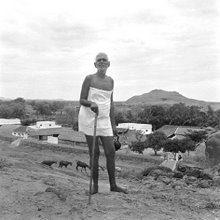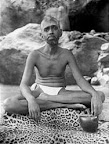"How can I describe the good fortune of Sabari?"
— Tyagaraja
LAKSHMI Ammal, usually referred to as Echammmal, belonged to Mandakolutur about twenty miles away from Arunachala. At one time she lived at Karedu village in Nellore district where her husband was posted. Her first born, a boy, passed away. Later she had a boy and a girl.
One night, in a dream, a young boy clad in a cod piece and with a clean shaven head placed something in her hand and disappeared. He was possibly a sannyasi. She consulted a person knowledgeable in omens, who said that the boy was Kumaraswami, the family deity of her in-laws. She concluded that he gave her a prasadam in the dream but she had no way of knowing the form of the prasadam.
Her husband was transferred to Kandukuru. The same form once again appeared in Echammal's dream and placed a letter, written in Sanskrit script, in her hand. She told him that she could not read that script whereupon the form indicated to her whom she should consult. That person was a Sanskrit Pandit living in the same town. She went to him. He also said that it was Subrahmanya's prasadam and initiated her in an appropriate mantra.
Calamities befell her almost all at one stroke. Her son, daughter and husband passed away one after the other in quick succession. She bore them stoically and went back to her place with her last daughter. When the girl was about ten Echammal fixed up her marriage. A few days before the wedding the girl developed high fever. Again in her dream the boy appeared and said "Three births of yours are over. Viswanatha is asking for you. Come to the hill." A few days after the dream the girl passed away.
Echammal lost her last support and life became miserable. The village and the cottage where she lived were full of memories and on that account became intolerable. The words of consolation offered by her relatives were unbearable. Thinking that a change of place would do her good she obtained the permission of her father to visit pilgrim spots where she could be of service to sadhus. She stayed at the pilgrim centre of Gokarna on the western coast and served sadhus. She learned ashtanga yoga from a guru who came from the north. But her agony continued to smoulder and she saw no one who could extinguish it.
She returned to her place in 1906 in the same mood as she left. Though she did so, she had a firm belief that service to a sadhu [?] was the only way her grief could subside. A relative of hers advised her to visit Arunachala where "Brahmana Swami lives. He is only twenty five and has extraordinary powers. He will be able to help you in your distress." The relative also encouraged her saying that even
if the Swami was silent those who served him with full faith were bound to benefit from it. Thereupon she left for Arunagiri. She had relations there but she decided to stay away from them. Accompanied by a friend she visited the Swami who was then staying at Virupaksha cave. She noticed that the form which had appeared in her dreams three times earlier was of this very Sadguru. She sat in silence for an hour. The Swami was as usual silent. She was not inclined to return, it was as if her feet got planted there. Yet she had to return. On reaching home she told her friend that the oppressive weight in her heart torturing her in the recent past had gone.
From that day she regularly visited the ashram, like an iron filing attracted to a magnet. She also began serving food to the Swami. She used the money sent by her father, and later by her brother, for the service of the Swami and his disciples. She would prepare food for them and serve it wherever they went. For a number of Ramana devotees her house became a lodging place.
Nobody knew how her tears dried up. Even if memories of her husband and children arose she would not be overwhelmed by sorrow as in the earlier days. All that she knew was that it was due to the guru's prasadam and grace. The Swami was her mother, father, guru and God. Her great reward was peace and devotion. She would accept anything that happened to her as Swami's grace and would promptly report to him.
With the permission of the Swami she adopted her niece, Chellammal, and performed her marriage. She
named her grandson after Ramana. One day, she received a telegram from her son-in-law saying that Chellammal had passed away- which came as a bolt from the blue. It was as if the old agony would once again overwhelm her but things were different by then. She had her saviour. She went to the Swami and showed him the telegram. The Swami was moved, he shed tears. The Swami was "one with those in distress!" Echammal attended the final rites and returned, carrying her grandson Ramana, as a symbol of her daughter's memory. She placed the infant in the Swami's lap, as she believed that both for herself and the child the Swami was the sole refuge. The Swami who recognised the intensity of Echammal's sorrow, once again shed tears. Though Echammal's comfort was shattered by destiny, service-oriented as she was, she did not have to try hard to overcome her latest shock.
It is assumed by some that though jnanis may be endowed with a kind heart they do not sympathise with the sorrows of the common people. For one who was the manifestation of Easwara could sympathy and affection towards his children be unusual?
The Swami dispelled Echammal's sorrow first and then gave her his upadesa. Earlier she had practised concentration on the nose and meditating on the brilliant light emanating there. She spent hours and days in a state of ectasy because of that. On one occasion when she was thus seated, totally oblivious of the outer world, the owners of the house mistook her to be dead and ran to the Swami to inform him. He heard the news and kept quiet. Later she told the Swami
how she practised yoga. The Swami said, "The brilliant light is a vision, it is not the atma realising which is your goal. Why do you go after lesser things?" Thus he taught her, diverted her from the yoga marga and put her on the path of self enquiry. She had full faith in him and followed his upadesa. The Swami showed her his grace in several ways. Here are a couple of such instances.
One day while Echammal was climbing the hill carrying food for the Swami there was a heavy downpour. She took shelter at a particular place and looked at the Swami who was not far away. She observed that the area surrounding him was absolutely dry whereas at a little distance from him it was raining heavily!
On another occasion, a Pandit from the North visited the Swami at Virupaksha cave and was discussing some subtle points with the Swami. When Echammal reached the cave as usual she was astonished at what she saw. She began trembling when the Swami asked her the reason. She narrated her experience thus: On reaching the Sadguru Swami cave on her way, she felt that there were two persons - one of whom was the Swami and the other the visitor close by. Without halting she moved along. As she was doing so a voice said "Why climb when he is here?" When she turned back she could see nobody at the spot or nearabouts. She trembled with fear at this experience and somehow reached Virupaksha cave. The Sastry then said to the Swami. "You have been speaking to me here but appeared before her at a different place! You have not blessed me with your grace similarly."
The Swami merely said that because Echammal was constantly thinking of him she saw his form elsewhere. But the question still remained as to why she should see the visitor also!
Another day as Echammal was going towards the cave of the Swami she noticed on the top of a tree a crow poking a parrot . As the parrot fell to the ground Echammal picked it up and took it to the Swami. Despite careful nursing by the Swami the parrot died after a few days. The Swami arranged for the burial of the parrot and pronounced that a building would rise at the spot. Just as he said, subsequently, a building arose close by. The cave adjacent to it got the name Kili guha (Parrot cave).
The Swami never subscribed to the view that women were not fit for self-enquiry. Kavyakanta Ganapati Muni's wife Visalakshi once asked Bhagavan about this. He replied that women who abided in the Self could become renunciates too and that upon death their bodies should be buried. This point is referred to in Sri Ramana Gita (Chapter 13).
Echammal was a sattvic devotee. With all her devotion to the Swami she never ignored other great souls. She had great devotion for Seshadri Swami also who was pleased with her goodness and devotion. Seshadri Swami who neither allowed others to come near him nor go to others, would visit Echammal's house. He escorted her back home a number of times when she returned from the ashram, if it was dark by then. One day, a Pandit was reciting a Purana and explaining it in Echammal's house. Suddenly Seshadri Swami appeared there. The Pandit
contemptuously said of him, "Will people of this type ever obtain jnana [?] even in a thousand births?" Echammal felt bad and thought within herself that it would be fitting if Seshadri Swami gave a discourse to vanquish the Pandit's pride. On his own, Seshadri Swami gave a discourse without the aid of any book for about an hour and mesmerised the audience with his scholarship.
On another occasion, Seshadri Swami visited her when Echammal was performing her pooja and asked her what she was doing. She replied that she was worshipping the pictures of Seshadri Swami and Ramana. Seshadri Swami asked her why she did not meditate. Echammal knew about meditation but in order to elicit it from Seshadri Swami asked him to teach her how meditation was to be done. At once, Seshadri Swami sat there in padmasana and demonstrated how to meditate. He also fell into samadhi and stayed in that state for about four hours at the end of which he merely said "Have you noticed?" And went his way. Those who knew his nature could easily guess what a great blessing it all was.
The Swami rid Sivaprakasam Pillai of worldly desires and put him on the path of enquiry. He did the same for Echammal also. But for the Swami's grace how could a person immersed in sorrow because of worldly affairs, get on to the path of self-enquiry?
Referred Resources:
Sri Ramana Gita
Links to letters:
Echamma: (Chapter 15: Echamma’s Demise
Links to rl:
Ganapati Muni: (Chapter 22: Ganapati Muni
Virupaksha: (Chapter 18: The Peerless Hill
Ramana Gita: (Chapter 27: Sri Ramana Gita
Seshadri: (Chapter 25: Seshadri Swami
Seshadri: (Chapter 29: Giripradakshina
Sivaprakasam Pillai: (Chapter 20: Sivaprakasam Pillai
Echamma: (Chapter 40: Withdrawal of the Manifestation
Links to sp:
Links to gems:
destiny: (Chapter 11: Fate and Freewill





No comments:
Post a Comment